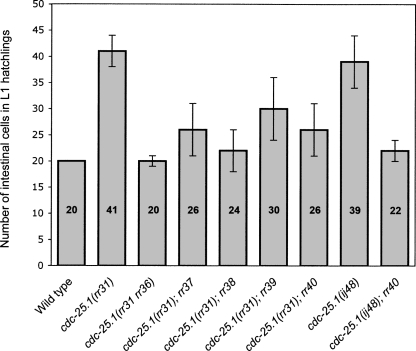FIGURE 1.
Isolation of five viable suppressors of the cdc-25.1(rr31)-associated intestinal hyperplasia. The average number of intestinal cells in L1 hatchings (sample size n > 50) is indicated for each genotype at 20°C. All animals express the intestinal-specific elt-2∷gfp marker that enables visualization and quantification of intestinal cells (Fukushige et al. 1999). Each of the suppressors (rr36–rr40) reduces the cdc-25.1(rr31)-associated intestinal hyperplasia specifically during embryogenesis, with no post-embryonic effect. rr36 is the strongest suppressor and corresponds to an intragenic mutation in the cdc-25.1 gene (Hebeisen and Roy 2008). cdc-25.1(ij48) corresponds to a second gain-of-function allele of the phosphatase that produces intestinal-specific hyperplasia similar to cdc-25.1(rr31) (Clucas et al. 2002). ij48 and rr31 both affect residues of the highly conserved DSG(X)4S destruction motif. Error bars represent standard deviation.

